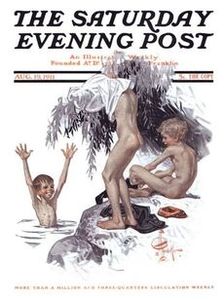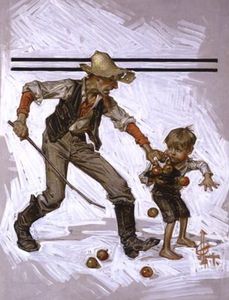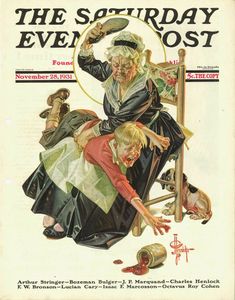J. C. Leyendecker
Joseph Christian Leyendecker (✦March 23, 1874 – †July 25, 1951) was one of the preeminent American illustrators of the early 20th century. He is best known for his poster, book and advertising illustrations, the trade character known as The Arrow Collar Man, and his numerous covers for The Saturday Evening Post.
Early life
Leyendecker (also known as 'J. C.' or 'Joe') was born on March 23, 1874, in Montabaur, Germany, to Peter Leyendecker (1838–1916) and Elizabeth Ortseifen Leyendecker (1845–1905). His brother and fellow illustrator Francis Xavier (aka "Frank") was born two years later. In 1882, the entire Leyendecker family immigrated to Chicago, Illinois, where Elizabeth's brother Adam Ortseifen was vice-president of the McAvoy Brewing Company. A sister, Augusta Mary arrived after the family immigrated to America.
As a teenager, around 1890, J. C. Leyendecker apprenticed at the Chicago printing and engraving company J. Manz & Company, eventually working his way up to the position of staff artist. At the same time he took night classes at the school of the Chicago Art Institute.
After studying drawing and anatomy under John Vanderpoel at the Chicago Art Institute, J. C. and Frank enrolled in the Académie Julian in Paris from October 1895 through June 1897. Upon their return to Chicago, the Leyendecker brothers took an apartment in Hyde Park. They also shared a studio in Chicago's Fine Arts Building at 410 South Michigan Ave.
Personal life
Sexuality
No statements (in Leyendecker's own words) survive concerning his sexual desires, behavior, or identity; however, what is known about his personal life fits the pattern historians have identified for many gay men who lived during his time.
Leyendecker never married, and he lived with another man, model Charles A. Beach, for most of his adult life (1903–1951). Beach was Leyendecker's studio manager and frequent model, and many biographers describe Beach as Leyendecker's romantic, sexual, or life partner. They also describe Leyendecker as "gay" or "homosexual."
Some historians have attributed the homoeroticism in some of Leyendecker's work to his sexuality while others have pointed to the collaborative nature of commercial art making, which suggests the content of Leyendecker's work was more expressive of the times in which it was created than the artist's sexuality.
Residences
In 1915, J. C., his brother Frank and sister Augusta Mary relocated from New York City to a newly built home and art studio in New Rochelle, New York, an art colony and suburb of New York City. Sometime after 1918, Charles Beach also moved into the New Rochelle home.
Leyendecker and Beach reportedly hosted large galas attended by people of consequence from all sectors. The parties they hosted at their New Rochelle home/studio were important social and celebrity making events.
While Beach often organized the famous gala-like social gatherings that Leyendecker was known for in the 1920s, he reportedly (by Norman Rockwell) also contributed largely to Leyendecker's social isolation in his later years. Beach reportedly forbade outside contact with the artist in the last months of his life.
Due to his professional success, Leyendecker enjoyed a luxurious lifestyle with a large home, domestic servants, and a chauffeured car. However, when commissions began to wane in the 1930s, he was forced to curtail spending considerably. By the time of his death, Leyendecker had let all of the household staff at his New Rochelle estate go, with he and Beach attempting to maintain their home themselves.
Death, burial, disposition of estate
Leyendecker died on July 25, 1951, of an acute coronary occlusion at his home in New Rochelle. He was buried alongside his parents and brother Frank at Woodlawn Cemetery in The Bronx, New York City.
Leyendecker's will directed his estate—house, furnishings, paintings, etc.—be divided equally between his sister Augusta Mary and Charles Beach. Though Leyendecker directed Beach to burn his drawings upon his death, Beach instead sold many of his drawings and paintings at a lawn sale.
Other Leyendecker works were sold through New York's Society of Illustrators or given to the New York Public Library and Metropolitan Museum of Art. Sister Augusta Mary Leyendecker retained many of J. C. Leyendecker's paintings for Kellogg's cereals, and donated them along with other family ephemera upon her death to the Haggin Museum.
Legacy
As the premier cover illustrator for the enormously popular Saturday Evening Post for much of the first half of the 20th century, Leyendecker's work both reflected and helped mold many of the visual aspects of the era's culture in America. The mainstream image of Santa Claus as a jolly fat man in a red fur-trimmed coat was popularized by Leyendecker, as was the image of the New Year Baby. The tradition of giving flowers as a gift on Mother's Day was started by Leyendecker's May 30, 1914 Saturday Evening Post cover depicting a young bellhop carrying hyacinths. It was created as a commemoration of President Woodrow Wilson's declaration of Mother's Day as an official holiday that year.
Leyendecker was a chief influence upon, and friend of, Norman Rockwell, who was a pallbearer at Leyendecker's funeral. In particular, Norman Rockwell's early work for the Saturday Evening Post bears a strong superficial resemblance to that of Leyendecker. While today it is generally accepted that Norman Rockwell established the best-known visual images of Americana, in many cases, they are derivative of Leyendecker's work, or reinterpretations of visual themes established by Rockwell's idol.
The visual style of Leyendecker's art inspired the graphics in The Dagger of Amon Ra, a video game, as well as designs in Team Fortress 2, a first-person shooter for the PC, Xbox 360, and PlayStation 3.
Leyendecker's work inspired George Lucas and will be part of the collection of the anticipated Lucas Museum of Narrative Art.
Leyendecker's Beat-up Boy, Football Hero, which appeared on the cover of The Saturday Evening Post on November 21, 1914, sold for $4.12 million on May 7, 2021. The previous world record for a J. C. Leyendecker original was set in December 2020, when Sotheby's sold his 1930 work Carousel Ride for $516,100.
Costume designer Carol Cutshall used Leyendecker's illustrations as inspiration for the costumes created for Anne Rice's Interview with the Vampire on AMC, a 2022 television series adaptation of the 1976 novel by American author Anne Rice. Of the clothing designed specifically for the male characters Louis de Pointe du Lac and Lestat de Lioncourt, Cutshall said, in part, "And the whole first two episodes, their style sense in many ways is a love letter to Leyendecker. Some things are just perfectly pulled from – like their formalwear, their tuxedos that they wore to the opera in 1917, and the black pinstripe suit with the green tie and the white boutonniere that Lestat wears to the du Lac family home for dinner – those are from a Leyendecker illustration." Cutshall also referenced Louis and Lestat's clothing being created from Leyendecker's illustrations as a way to draw a parallel between Louis and Lestat, who were shown in the series as having to keep their romantic relationship hidden from the public in the 1910s and 1920s, and Leyendecker and his life partner, Charles Beach.
Films and plays
In Love with the Arrow Collar Man, a play written by Lance Ringel and directed by Chuck Muckle at Theatre 80 St. Marks from November to December 2017, dramatizes the life of Leyendecker and his life partner Charles Beach.
Coded, a 2021 film documentary, tells the story of Leyendecker and premiered at the TriBeCa Film Festival in 2021.
Leyendecker's illustrations include at least two spanking related ones.
J. C. Leyendecker has been listed as a spanking artist on SAOTK
- Artwork by J. C. Leyendecker
See also [ List of spanking artists ]
- More information is available at [ Wikipedia:J. C. Leyendecker ]
Sources
- http://spankingart.org/wiki/List_of_spanking_artists#L
- https://en.wikipedia.org/wiki/J._C._Leyendecker
External links
Chat rooms • What links here • Copyright info • Contact information • Category:Root



